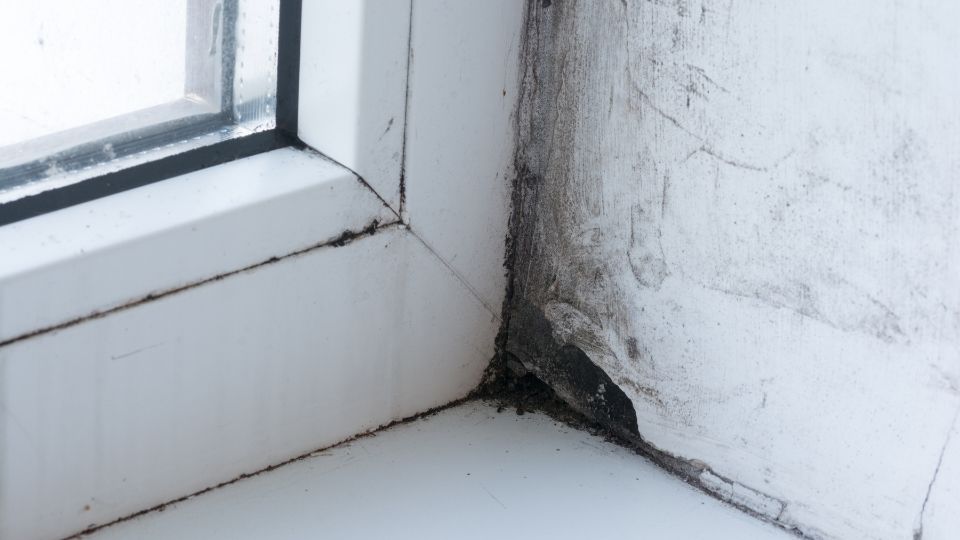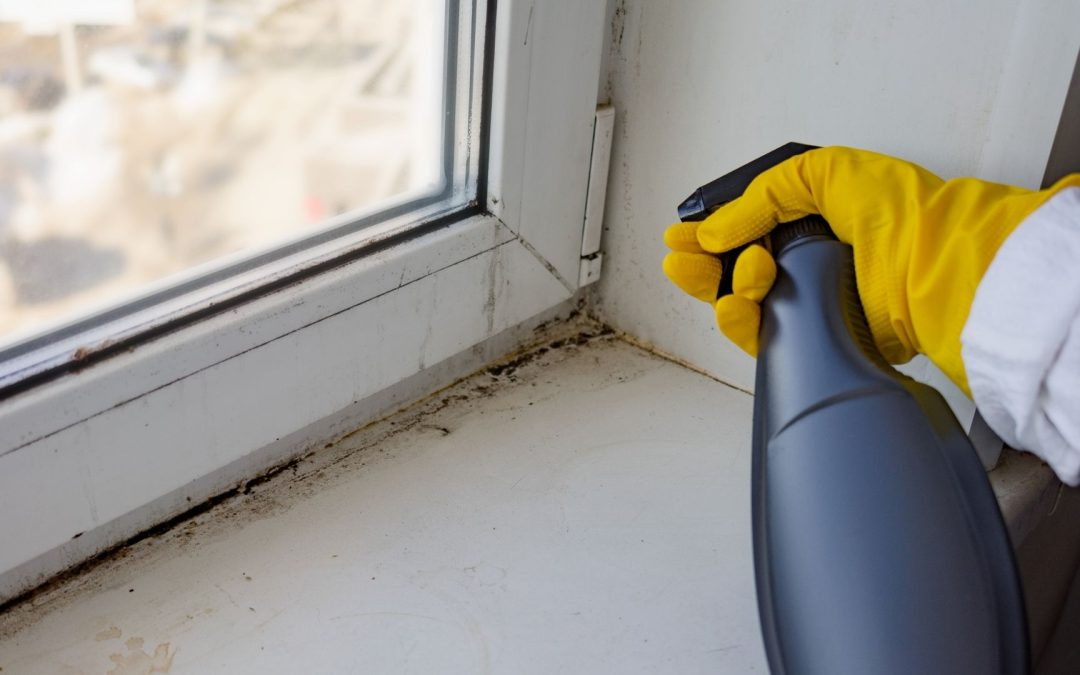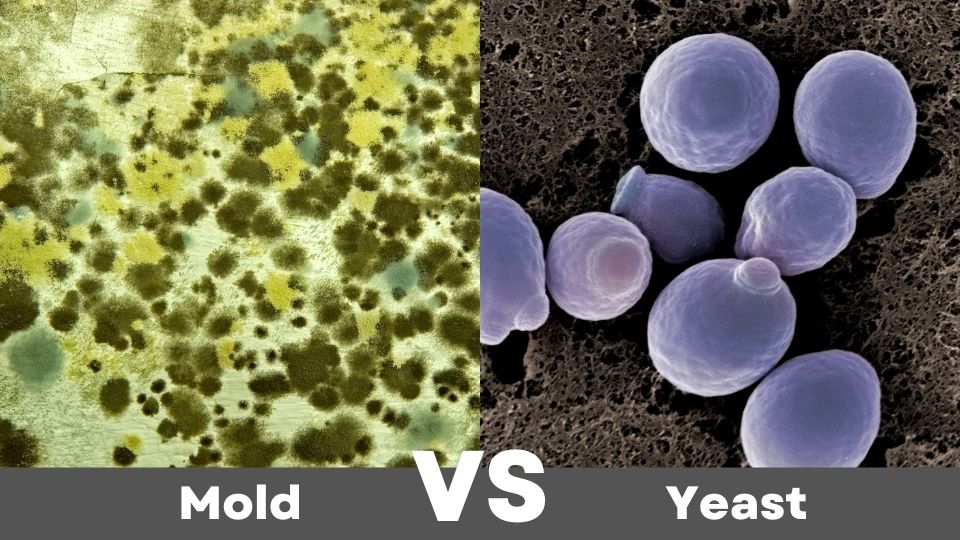
by Mold-B-Gone | Jun 13, 2022 | Mold Facts, Uncategorized
Mold are microscopic fungi that grow with ease in moist and dusty conditions. They are mostly present in bathrooms, under kitchen sinks, in areas where water has leaked into walls or floors and in wet insulated areas. Sometimes mold also grows on window sills. Mold growing on window sills is also as a result of moisture and dust accumulation. This dust and moisture is commonly found between window panes, along wooden window sills and frames. In certain scenarios, one may also find mold in window tracks. Any small crevices around a window can offer an ideal environment for mold growth if dust and humidity are present.
What Causes Mold around Windows?
In some cases, mold on window glass may occur as a result of air trapped in between two window panes. The most notable cause of this is condensation. This usually happens when the relatively warm air inside a room hits the window glass and gets rapidly cooled by the air outside, resulting in condensation. Some of the factors that may cause condensation include:
- Wet and humid weather.
- Inadequate heating.
- Leaking pipes
- Steam deposits caused by bath or shower.
- Wood burners and open fires.
Also see What Helps Mould Spread Through Your Home?
How to Prevent mold on window sills
It can be quite difficult to detect mold in between window panes since it develops in hard to see sections. It’s not surprising to find mold blending in with the color of your windows. This can make it almost impossible to detect it with an untrained eye. Some of the simple solutions to prevent mold growth include:
- Proper ventilation in bathrooms and turning on the extractor fan. This is to ensure that all the steam produced while a shower or bath is running is able to escape. You can also wipe down wet surfaces to aid the process.
- Dehumidifier-This machines come in a variety of sizes and help to get rid of excess moisture in the air.
- Maintaining your home’s constant temperature will help control the condensation levels. This is because when warm air rapidly gets cold then warm again, moisture is produced creating an ideal environment for mold to grow.
- Double glazed windows- creating an insulating layer between the cold outside and the warm inside is an efficient method to curb mold growth. Blocking heat from passing inside to outside and vice versa means that the inner pane is constantly warm, preventing the ideal conditions for mold growth.
After doing your research on how to get rid of mold in windows, it’s recommended that you seek expert advice from professionals with proper protective equipment and sufficient knowledge. This guarantees that during the cleaning process, there’s low chances of the spores circulating throughout your home.
If you have questions regarding Mold removal in Atlanta or you’d like mold removed from your home professionally, feel free to contact Mold Remediation & Removal Atlanta, GA. They’ll ensure your damaged house or property receives the best possible mold treatment.

by Mold-B-Gone | Jun 9, 2022 | Mold Facts, Uncategorized
Did you know that mold the size of a fist can produce thousands of mold spores into the atmosphere? Once the spores are airborne, they can be inhaled by the occupants of a house. What happens next is that an irritation develops in the lining of the throat leading to a mold exposure cough. Not everyone experiences cough due to mold since it does not infect every single occupant of a house. However, infants, children and the elderly are at a much higher risk of being affected. People suffering from respiratory diseases are also in danger of contracting coughing from mold. Extreme exposure of mold has been known to affect even pets.
Other notable symptoms of what breathing in mold can do include:
- Sore throat
- Running nose
- Headaches
- Wheezing
- Shortness of breath
- Sneezing
Other respiratory diseases related to mold such as pneumonia and bronchitis are also accompanied by coughing. However, it is important to seek medical advice from your doctor to determine if mold does make you cough. Once you are tested, the doctor will prescribe antibiotics to deal with the existing underlying infection.
Are There Treatments For Cough Caused By Mold?
Antihistamines may also be prescribed to aid the mucus in drying up. Cough tablets and syrup can help curb consistent coughing especially if you are not getting any sleep because of it. To soothe your cough and prevent further damage to your throat, use cough drops.
Headaches are also heavily associated with coughing, so it’s possible that the doctor would also prescribe some painkillers.
Related: What Is The Link Between Mold and Asthma?
You are highly advised not to buy over the counter drugs especially if you have an existing prescription. Instead, you should seek help from a qualified medical practitioner.
To facilitate your healing process after coughing from mold, you need to permanently remove yourself from the infected areas. Failing to do so means that your condition will deteriorate.
How Do I Prevent Cough From Mold?
It’s important that you carry out a thorough mold removal process in your household and enforce preventive measures to help curb mold related illnesses. To successfully do this, you need to identify the source of moisture on your walls and deal with it. Ensure you remove the contaminated materials then conduct proper cleaning on the affected areas.
Other respiratory diseases related to mold such as pneumonia and bronchitis are also accompanied by coughing. It’s therefore recommended you seek experts that will arrange a home visit. Their qualifications and experience come in handy to help make sure that all mold affected areas receive the best possible treatment. Most of the time, these home visits by mold removal companies are free so no form of payment is required upfront.
If you’ve recently suffered from a mold related illness, ensure you are not involved in the process of mold removal and instead seek help.
Mold Remediation Atlanta
If you have questions about mold remediation in Atlanta or you’d like help removing mold in your home, contact Mold-B-Gone for Mold Remediation & Removal Atlanta. They have a track record of helping so many homes around Atlanta eliminate mold. Try them out today.

by Mold-B-Gone | May 16, 2022 | Mold Facts
Mold is a fungus that can be found both indoors and outdoors. It is often green, black, or white in color, and it grows in humid environments. Mold can cause a number of health problems, including respiratory issues and skin irritation. But can mold cause sore throats? In this blog post, we will discuss the link between mold and sore throats, as well as some tips for preventing mold-related health problems.
Reactions to Mold Can Vary
Depending on a person’s sensitivity to mold and the amount of mold present, some people may experience no symptoms at all, while others may develop a sore throat, coughing, or difficulty breathing. In severe cases, mold exposure can lead to pneumonia or other serious respiratory illnesses. If you are concerned that you may have been exposed to mold, it is important to see a doctor as soon as possible.
Learn more by reading What Is the Link Between Mold and Parkinson’s Disease?
Mold spores are often found in the air, and they can enter your body through your nose, mouth, or eyes. Once they are inside your body, they can travel to your lungs and begin to grow. This growth can cause inflammation and irritation in your lungs, which can lead to a sore throat. Mold spores can also cause allergic reactions, and people with allergies to mold are more likely to develop a sore throat after exposure.
Reducing Your Exposure to Mold
There are a few things you can do to reduce your risk of developing a mold-related health problem. First, try to keep your home clean and free of clutter. This will make it easier to spot mold growth and clean it up before it has a chance to spread. Second, use an air purifier or HEPA filter in your home to remove mold spores from the air. Finally, if you have any medical conditions that make you more susceptible to respiratory infections, be sure to see your doctor for regular checkups and get vaccinated against influenza and other respiratory viruses. By taking these precautions, you can help protect yourself from the harmful effects of mold.
Conclusion
Mold can cause a number of health problems, including sore throats, but with the right precautions, you can protect yourself from its harmful effects. If you think you may have been exposed to mold, be sure to see a doctor as soon as possible. And remember, the best way to prevent mold-related health problems is to keep your home clean and free of clutter. Thanks for reading! And if you need commercial mold inspection in Atlanta, give us a call.

by Mold-B-Gone | May 2, 2022 | Mold Removal
Mold is a type of fungus that can grow almost anywhere there is moisture and organic material. It can cause health problems in people who are allergic to it, and it can also damage property. If you have mold growing in your home, you may be wondering if bleach is an effective way to treat it. In this blog post, we will explore the effectiveness of bleach at treating mold and provide some tips for preventing mold growth.
Does Bleach Kill Mold?
The answer to this question is both yes and no. Bleach can kill mold on hard surfaces, such as tile and glass. However, bleach does not kill mold spores on porous surfaces, such as wood and drywall. The reason for this is that bleach only kills the mold spores on the surface of the material. It does not penetrate into porous materials to kill the roots of the mold. As a result, mold can quickly regrow on treated surfaces if they are not properly cleaned and dried afterward.
So, while bleach can be effective at killing mold on some surfaces, it is not a complete solution for mold removal. If you have mold growing in your home, you should contact a professional Mold Remediation company to have it removed.
Preventing Mold Growth
The best way to deal with mold is to prevent it from growing in the first place. There are a few things you can do to reduce the risk of mold growth in your home:
- Keep indoor humidity levels low, ideally between 30 and 50 percent. Use a dehumidifier or air conditioner if necessary.
- Fix any leaks in your plumbing or roof as soon as possible.
- Ventilate damp areas such as kitchens, bathrooms, and laundry rooms. Use an exhaust fan or open a window when cooking, showering, or doing laundry.
- Use mold-resistant products when remodeling or building new construction. Materials such as drywall, paint, and carpet that are labeled “mold-resistant” can help to prevent mold growth.
Need basement-specific ideas? Read 10 Tips to Prevent Basement Mold.
Following these tips, you can help to prevent mold from growing in your home. However, if you already have mold growing in your home, it is best to contact a professional Mold Remediation company to have it removed. Bleach can be effective at treating mold on some surfaces, but it is not a complete solution for mold removal. Taking steps to prevent mold growth is the best way to keep your home healthy and free of this damaging fungus.
Contact us today if you need mold cleaning service in Atlanta. We are here to help! Visit our website or give us a call.

by Mold-B-Gone | Apr 20, 2022 | Mold Facts
Do you know the difference between mold and yeast? If not, you’re not alone. Many people don’t know the difference, or even that there is a difference! In this blog post, we will discuss the differences between mold vs. yeast, as well as some of the health risks associated with each. We will also provide tips on how to prevent mold and yeast growth in your home.
Learn more by reading Mold vs. Fungus: Their Similarities and Differences.
What Is Mold?
Mold is a type of fungi that can be found both indoors and outdoors. Mold grows in moist, warm environments and can often be found in damp areas such as basements, bathrooms, or kitchens. Mold reproduces by releasing spores into the air. These spores can cause allergic reactions in some people, including runny nose, sneezing, watery eyes, and coughing. In severe cases, mold exposure can also lead to difficulty breathing.
Those with asthma or other respiratory conditions are especially at risk for health problems related to mold exposure. If you suspect that you have a mold problem in your home, it is important to have it addressed immediately by a professional.
What Is Yeast?
Yeast is a single-celled microorganism that is classified as a fungus. Unlike mold, yeast grows best in warm, sugary environments. Yeast is often used in baking to help bread rise. It can also be found in beer and wine making. When yeast ferments, it produces alcohol and carbon dioxide gas.
Yeast infections are a common type of fungal infection. They can occur on the skin or in mucous membranes. However, yeast can also grow on the surfaces of your home if the right conditions are present.
How Can I Prevent Mold and Yeast Growth In My Home?
There are several things you can do to prevent mold and yeast growth in your home:
- Keep your home clean and free of clutter.
- Fix any leaks or other sources of moisture immediately.
- Ventilate damp areas such as the kitchen and bathroom.
- Use an air conditioner or dehumidifier to control humidity levels.
- Be sure to dry wet areas completely after cleaning them.
Mold and yeast can both be dangerous to your health, so it’s important to be aware of the signs of each and take steps to prevent their growth in your home. If you think you may have a mold or yeast problem, contact our professionals for mold removal in Atlanta.





